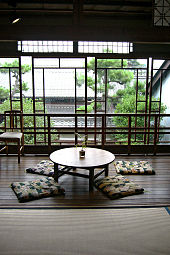Chabudai

A chabudai (卓袱台) is a short-legged table used in traditional Japanese homes. People seated at a chabudai may sit on zabuton or tatami rather than on chairs. The four legs of a chabudai are generally collapsible so that the table may be moved and stored easily.
Chabudai are used for various purposes, such as a study table for children, a work bench for needlework, and most importantly, a dinner table for the entire family (shokutaku (食卓、しょくたく)). In the winter, the chabudai is often replaced by a kotatsu, another type of short-legged table equipped with a removable top and a heater underneath.
Chabudai gaeshi
Chabudai gaeshi is a Japanese phrase meaning to flip [the] chabudai. Literally, it describes the act of violently upending a chabudai as an expression of anger, frustration, and disapproval. Video game designer Shigeru Miyamoto characterized chabudai gaeshi as an "action of old-fashioned Japanese fathers" which "would destroy the family" if attempted literally in modern Japanese society.[1] Chabudai gaeshi may also figuratively describe an analogous outburst and upheaval.
A Japanese arcade game, Cho Chabudai Gaeshi, is based upon the scenario of Chabudai Gaeshi.[2]

